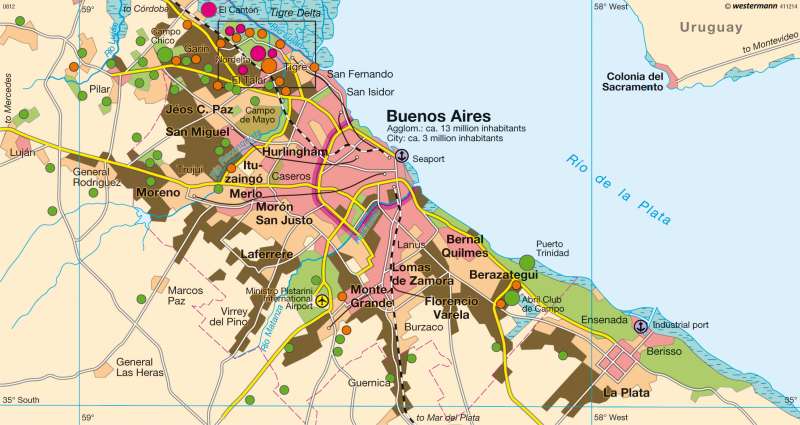Buenos Aires (Argentina) — Rich and poor
South America
978-3-14-100790-9 | Page 151 | Ill. 3

Information
Buenos Aires is not only the political and administrative capital but also the economic and cultural centre of Argentina. The actual city of Buenos Aires (Capital Federal) covers an area of only 203 square kilometres, and is home to some three million people. The greater metropolitan area (Gran Buenos Aires) extends over a distance of 100 kilometres along the banks of the Río de la Plata and some 40 kilometres into the interior. About 13 million people — roughly one-third of the entire population of Argentina — live in the metropolitan area.Rich and poor
The stark social contrasts within Argentine society are clearly evident in Buenos Aires. A growing majority of the poor coexists with a wealthy minority. Despite an early phase of economic growth, the neo-liberal economic policy pursued by the government since 1991 has been accompanied by increasing unemployment, and has progressively widened the gap between rich and poor. In the years preceding 2001, 80 percent of the inhabitants of the Buenos Aires metropolitan area experienced losses of real disposable income. That figure has risen since 2001 in the wake of the national economic and financial crisis and again since 2008 as a result of the global financial crisis. The middle class is gradually moving into suburban space formerly occupied primarily by low-income families — thanks in part to the private highway network that was privatized in the early 1990s. Since the mid-1990s, more than 450 private residential estates (barrios privados) with housing for over half a million people have emerged on the periphery of Buenos Aires. At about the same time, several smaller gated housing areas in the form of high-rise towers and converted estates were created in central Buenos Aires.
Private suburban housing estates
Most private housing areas are situated in northern Buenos Aires, near the Tigre Delta, where the Río Paraná flows into the Río de la Plata. The most important types of private housing areas are the "country clubs", the barrios cerrados and the "private cities". "Country clubs" have been built around football fields, tennis courts, golf courses and polo and riding grounds and were originally conceived as weekend estates. Today, however, most such clubs serve as primary domiciles for an affluent clientele. Barrios cerrados are newly constructed, gated, middle-class housing estates built as groups of single-family homes on relatively small lots on the fringe of the city. "Private cities" are outgrowths of the most recent trend in private housing construction. They are estates composed of several thousand housing units along with their own sport and leisure facilities, private schools and shopping centres. These communities are connected to city centre by separate highway and rail connections. Houses and lots in these private cities vary considerably, and they consist of both single-family homes and apartment complexes.
H. Kiegel; Ü: J. Southard




